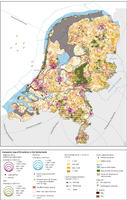
A recent analysis by PBL, the Netherlands Environmental Assessment Agency, has mapped key EU policies that influence land in the Netherlands. This map shows the results, including: locations supported by EU subsidies under the Common Agricultural Policy (pillars 1 and 2), EU regional policy, the LIFE+ Programme and the fisheries fund; Trans-European Transport networks (TEN-T); safety zones designated under the Seveso Directive (2012/18/EU); river basin districts as well as water bodies who quality is insufficient; and Natura 2000 sites (both terrestrial and marine) as well as their zones of influence.

Blue dots indicate outflow to suburban areas; red dots indicate inflow to cities. The largest blue dots indicate areas in which there has been a 2.9 % or higher outflow of the urban population to the suburban area, medium-sized dots indicate a 1.45 %–2.9 % outflow and the smallest dots represent an outflow of 0.29 %–1.45 %. Red dots indicate the reverse phenomenon (i.e. the concentration of the population in city centres).
Source: Euroreg (2010).

Urban sprawl at 1-km2 scale in 2009 (WUPp) in six examples of zoom-ins: (a) from the coast of Spain (Barcelona), (b) Paris, (c) from the Benelux countries, (d) Dublin (e), Helsinki, and (f) Warsaw.